To end this month of “Burnout”, I thought it might be fun to reinterpret the theme title and take a look at the sound design for a classic series of racing games that bear the same name. So allow me if you will, to take you… back in time!
The year was 2001.
It was the year the gaming world debuted the gruff yet dulcet tones of Max Payne.
It was the year Final Fantasy dropped to a single Roman numeral as it reached the “X” milestone.
It was the year that Yuri got his revenge.
And it was the year that this photo happened…
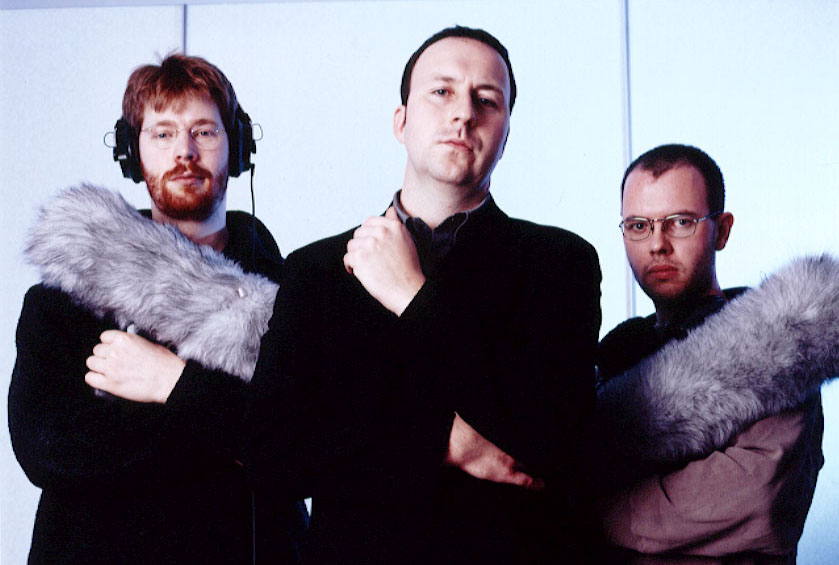
One set of headphones, two blimps, and three steely looks is all that was needed to define the sound of the”Burnout” games. A series that would go on to span eight years, eight games in total crossing ten different platforms.
Chances are you’ve owned, played or at least know of this series that was a defining part of my high-school and early college years. I have crystal clear memories of my roommates and I constantly swapping controllers as we tried to best our times on the Airport Terminal 3 track in “Burnout 2: Point of Impact”.
For those who’s memories are a little hazy however, here’s a refresher…
Ben Minto was kind enough to search though his memory archives and share some of his insights and tales from his time on the series. Ben worked as a audio designer on the series from the initial “Burnout” in 2001 though to 2008’s “Burnout Paradise”.
Before we delve into the interview, here’s a gameplay clip that features several of the things Ben discusses below.
Designing Sound: What role did sound play in the series, how was it viewed within the development team?
Ben Minto: Sound was key to the overall experience. When we (the original three person sound team of Stephen Root, Peter Bishop and myself) joined Criterion, from Acclaim, the game (codenamed SRC or Shiny Red Car) and the team making it were crying out for audio.
Everyone knew that without compelling sound, it was going to be very hard to sell the extremes of thrashing a car to its limits against competitors whilst weaving in and out of traffic and then the visceral, destructive, and yet in its own way rewarding, experience of ploughing head long into a crash.
As a team, not just the audio group, we all knew that those were our two big “Hollywood-esque” moments, so a lot of energy and effort went into selling them. In the ideal scenario you would be flipping back and forth between these two high adrenaline stages, constantly on the edge of your seat – pure arcade thrills!
DS: How was it working with a series across multiple platforms and console generations? Did the toolset evolve for each title or did you start from scratch on each occasion?
BM: Criterion built RenderWare, a middleware solution (which included the RenderWare Audio component), so all our titles were built on that. This made it relatively easy for the first two titles to ship across PS2, GC and XB, with the PS2 being our lead platform. For Burnout 3 and 4, we again led on the PS2 and then shipped on the PS2 and XB. Burnout (Revenge) 4 was eventually ported to the XB360. The code base for these first four titles evolved over each title while Burnout Paradise was a whole new beast built from the ground up.
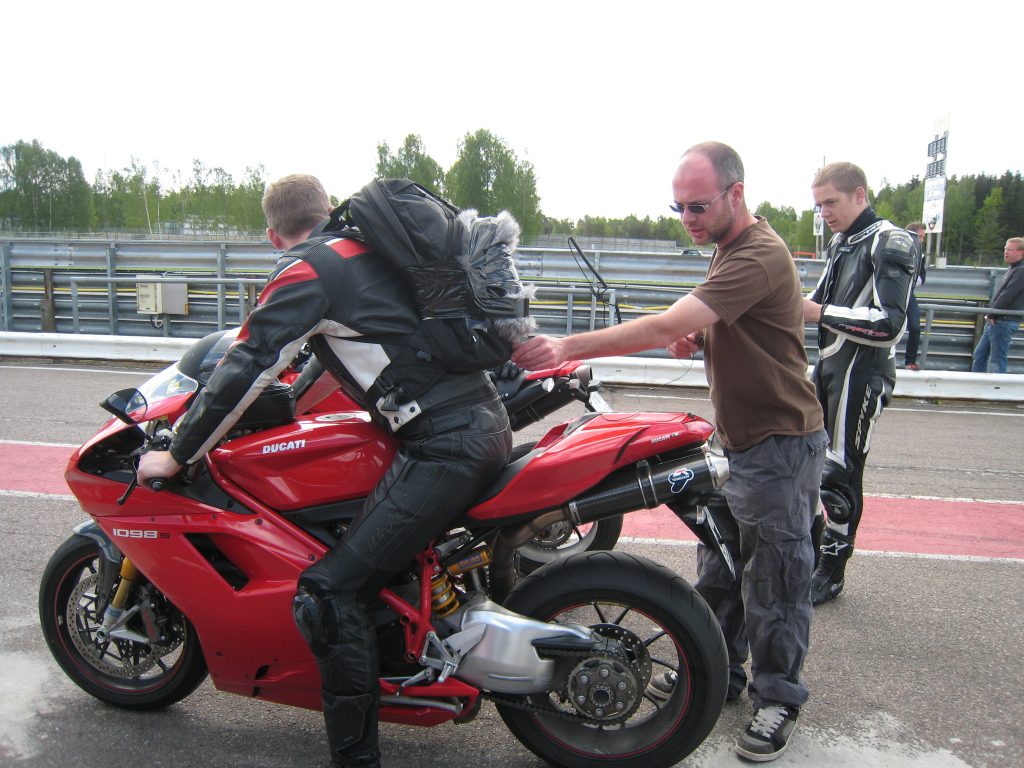
DS: Were you mostly using in-house tools? What was some of the most interesting functionality developed for the series?
BM: All in house tools. We had a very fortunate setup in that we had one audio programmer per sound designer, which is pretty much unheard of. So whilst we didn’t have a great toolset out of the box, we generated a lot of unique custom and very optimised solutions as we went.
For Burnout 1 we used Fourier Resynthesis for the engines, hence why they sound quite synthetic/tonal. The principle is that you start with real recordings taken at different fixed RPMs, and then remove the fundamental and a series of harmonics from these, almost akin to a split into tonal and noise components (something that today you can do in RX in seconds!). The noise parts (derived from the real recordings minus the fundamental and harmonics) you would then crossfade between across the RPM range, whereas the tonal parts are resynthesied from sinewaves and the mix of harmonics (additive synthesis) can be controlled across the RPM range, and varied with gear, speed, load etc. This helped to remove phasing as you crossfaded between samples and you could always keep bass in your overall sound (as it was easy to generate subharmonics given the fundamental), but it also took a lot of life out of the original recordings.
For Burnout 2 (Point of Impact), we had help from Rabin Ezra from the core Renderware team to develop a Wavefolder, which he optimised in Assembler so that we could use it at runtime on all 3 consoles without too high of a DSP hit. This combined with simple clip was our realtime distortion solution to give the engines more bite at the top end and to sell the more extreme engines. This, together with focusing more on the ‘real’ noise components, as well as adding in proper turbo, super charger models etc. brought some life and grit back to our engines.
With Burnout 4, we tried to integrate the Ginsu (granular playback) system pioneered by Patrick Ratto at EA, which was core to the sound of the Need For Speed titles developed by Charles Deenen and his team out of Black Box in Vancouver. Criterion had been bought by EA the year before, so this technology “harvesting” was an obvious step forward for us. Whilst it didn’t ship on the PS2 and XB versions of Burnout Revenge, for us it made its debut in the XBox 360 version of Burnout Revenge and is still the basis for modelling car engines across EA, most notably (a few generations on) in EA Ghost’s NFS titles.
DS: Could you talk about the approach to the series’ general speed and the “Burnout” boost effect which results in a dynamic change to the soundscape?
BM: For the first Burnout, boost wasn’t such a big thing. The cliché heartbeat and a focusing of the mix was all we implemented, fairly similar to Thrill Drive which was a key reference for our first title.
About a month before the first Burnout shipped, the first The Fast and The Furious hit the cinemas and that changed everything for Burnout 2 (Point of Impact) and onwards. Taking inspiration from the film gave us the confidence, and a target, to go way over the top with the boost and sense of speed sounds, and to treat being in boost as an unreal and extremely exaggerated experience.
Even when not in boost the arcade nature of Burnout meant that most cars accelerated at a rate about twice that of a F1 car! This was exaggerated further whilst using boost, so if we just followed what the needle said (the RPM counter) we would reach our highest steady state (an 8000 RPM constant whine or there abouts) very quickly and stay there for a long time (especially if you managed to chain boosts) – not the most satisfying soundscape. So the first step was to focus away from the engine, and then highlight all the “sense of speed” one shot events eg. passbys, horns and utilise tricks like a subtle Shepard-Risset glissando based Boost turbo model, to always give the sensation of going faster.
After some time watching Bullitt, which was initially to get a feel for how vintage American muscle V8s sounded, we noticed that in the chase scenes Steve McQueen had a 17 speed (or so) gear box; he just kept on shifting up! From this idea, we fashioned the Infinite Gear model, which meant that we asymptotically approached (never quite reaching it and when we got close we would shift up ‘another’ gear) our previous steady state whine and again kept the soundscape constantly rising. Whenever the player backed off the gas or took a corner, we made sure to ‘shed’ as many gears as possible, so that we could start the climb to maximum all over again. Having at least three different sound models, with different pitch relationships helped us not overly focus on one single component, so say having engine, road surface, transmission and turbo whine, and a mix between them depending on your current situation, would prevent fatigue associated with just listening to one of those components.
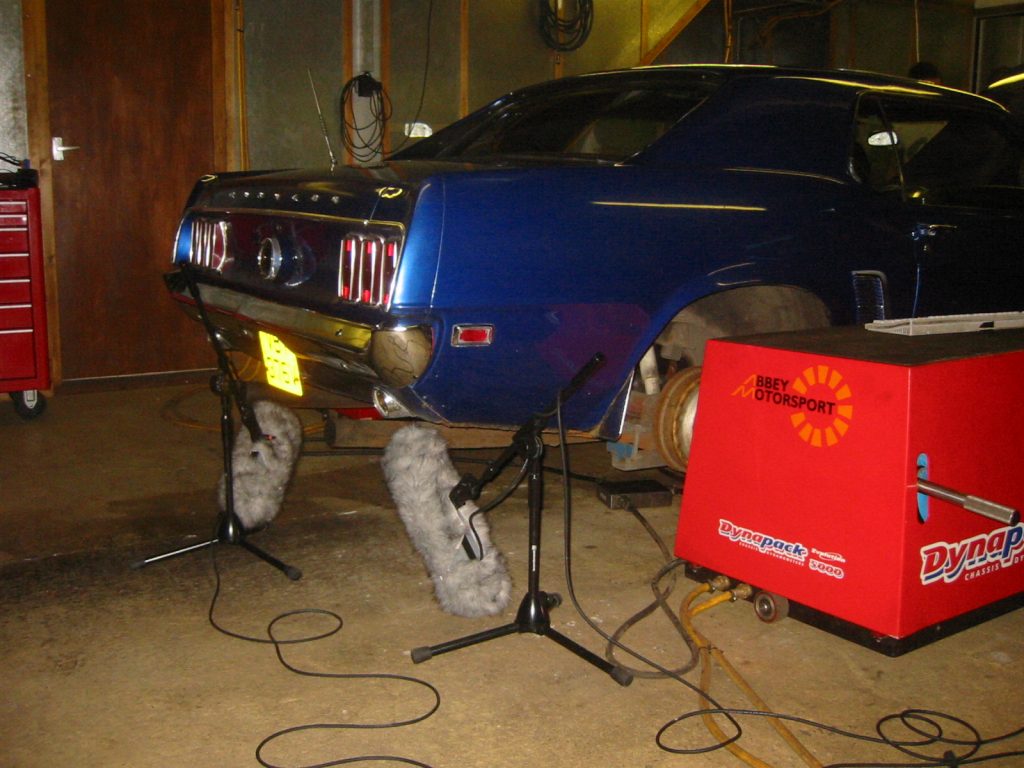
And of course there was the music switch, which we introduced in Burnout 2, the last title to have a fully custom written soundtrack, by Stephen Root and Steve Emney. I was implementing earlier versions of some of the songs into the game, and was asked by the producer Joe Bonar, after he heard these first tests, if it could be MORE, just MORE when you were going fast. MORE was initially louder, then it quickly became louder and distorted. I made a quick 4 channel wav (two stereo pairs) with a clean version and this MORE version of the track, which we then crossfaded between with speed. At idle you had clean and above say 150MPH you had (fully) the MORE version, and in between a mix of both. The effect was noticeable, but it really came into its own when we decided to keep the clean version for non-boost driving and then switch, covered by the overly loud nitrous injection boost sound effect, to the louder distorted version, whilst in boost. Stephen and Steve took this idea and then recorded each song twice; the clean version and then an extra version with additional instrumentation (kazoos! FTW!), layering and some distortion to further define and give extra uniqueness and inyourfaceness to the boost version of each track.
DS: What role did music play in the series?
BM: Music gave Burnout its own identity, as the whole fantasy of racing fast unlicensed cars and not seeing crashing as a failure, didn’t exist outside of the title, so there was no existing cultural references that we could easily tie into, compared to many other racing titles
The first two titles had bespoke electronic based, very arcade-y music and then from Burnout 3 onwards we had a predominately licensed ‘alternative’ soundtrack.
With the first two titles music was used to differentiate between two distinct states. In the first title each course had its own “blue sky racing” piece (think Daytona, Outrun etc racing in perfect ‘happy’ conditions, blue sky, no clouds, birds singing etc.) and then a more ominous tension piece for when time was running out and you are in danger of not finishing.
In the second title again the base track was a blue sky piece and as previously mentioned we used a system of swapping to a more intense version of the same track whilst in boost. For B3 onwards, as the soundtrack was licensed, we just mixed the music louder in mix when boosting.

DS: How do the pass by “whoosh” effects work?
BM: For static objects (street furniture, buildings, bridges, tunnels) it was a raycast system angled forwards from the car, with the angle increasing with speed (picture a joust). All whooshes were one shot so you want to trigger then in advance so the midpoint happens at the point you pass. Then we would use simple logic. For the up raycast, for example, the logic followed these type scenarios;
Have I hit anything? Yes
Wait a frame
Am I still hitting it? No, ok lamppost – play small whoosh
Have I hit anything? Yes
Wait a frame
Am I still hitting it? Yes
Wait a frame
Am I still hitting it? Yes, ok it’s probably a bridge (or tunnel entrance) – play big whoosh in
Simple rules like that were used to determine what type whoosh to play. For dynamic objects it was a relative velocity system, where if you know the relative velocity of approach you can again trigger a pre-rendered sound so its midpoint passes by the listener at the right point. If you make the attack on all passbys a fixed duration, then the calculation is easy. If your play the whooshby on the object you are passing then you know what it is and can play a relevant sample, e.g. other racer, traffic car, truck
We implemented Dolby Pro Logic 2, for Burnout 2, which helped with our sense of speed passbys. We even distorted/warped the PL2 lookup table during boost for objects that passed close by the listener to even further exaggerate the speed they went by you. This was paired with the “Minto Effect” (great name as used in code!) which was an extension to the standard “Doppler Effect” model, that would change ‘shape’ as you went faster. The amplitude curve would raise to a higher power, giving a lot sharper attacks and decays, so a snappier punchier by (quick PUNCH in & quick out) and the pitch curve (for standard Doppler shift at fixed speed this is, as you passby a source, higher constant pitch, snap by, lower constant pitch) would slope up on approach and down once you had passed, in effect suggesting that you were always accelerating past an object, even though your passby was at constant speed.
DS: How about the crashes in the series, how did sound for those moments work?
BM: Crashes defined Burnout. They were our most unique selling point. Internally, within EA, we were known as “The Crashing Game”. In the first two titles they were purely component based and physics driven, a very one to one construction – metal bonnet hit tarmac, headlight smash, windscreen crack, wheel arch scrape down road, chassis bend etc. – a series of individual events which resulting in a sound collage. And while this was ‘right’ and matched what happened on the screen it didn’t often sound very good.
With the introduction of licensed music, we no longer needed our 4 channel state swapping music player and so we repurposed it for ‘crash streams’. A crash stream had two stereo tracks – the first ‘real’ version had a stereo (!) high quality long initial impact followed by 30 seconds of generic car mangling, creaks, strains, wronks etc. The second stereo stream was for the slow mo crashes and had the same initial BANG but went off on a completely surreal angle. The slow mo crash stream played at the same volume during slow mo (player controlled as to which state you were in), whereas the real had its volume modulated in relation to the crash’s intensity and filled in the gaps between the individual one shots, as used for the first two titles, to give a better sounding crash experience.
Content wise we progressed over the titles in terms of source material, which started as mostly library material and expanded to include custom recordings (scrapyards, car drops etc.) and in terms of granularity in the samples, from catch-alls like metal medium and car glass to specifics like carbon fibre bumper and side window, especially when we made the jump to (at the time) next gen.
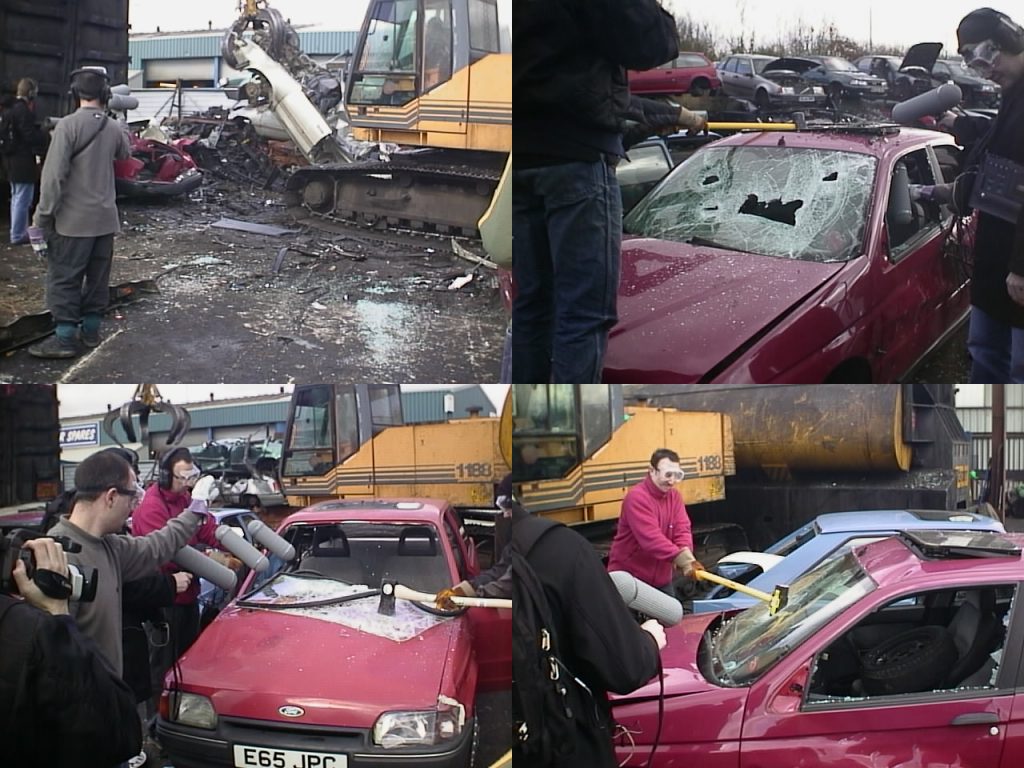
DS: Does “Crash Mode” have any unique audio components as opposed to a traditional race?
BM: Yes. As memory budgets were very tight and precise, we knew for each mode exactly how much RAM we could spend. As Crash mode didn’t have AI racers that saved us in the order of 180kb (on the PS2, which was about 10% of the total available), which was mainly used to add a second crash bank with more one shots thereby giving the crashes in crash mode more variety. How?
After a crash had occurred we would try and swap out a crash bank for another (for each crash bank we made 20 variants, so 20 batches of metal impacts, glass shatters etc samples). In the racing modes this was between successive crashes (as there was a guaranteed minimum time between crashes in which we could swap a bank in and out) and in crash mode as we had two banks we could ‘flip-flop’ the main crash banks during one long crash event to avoid repetition.
DS: How do the instant crash/race replays work with respect to sound?
BM: We just stored the events and “played” the game again, using the same “controls”. So yeah it could sound a bit different – which wasn’t a bad thing!
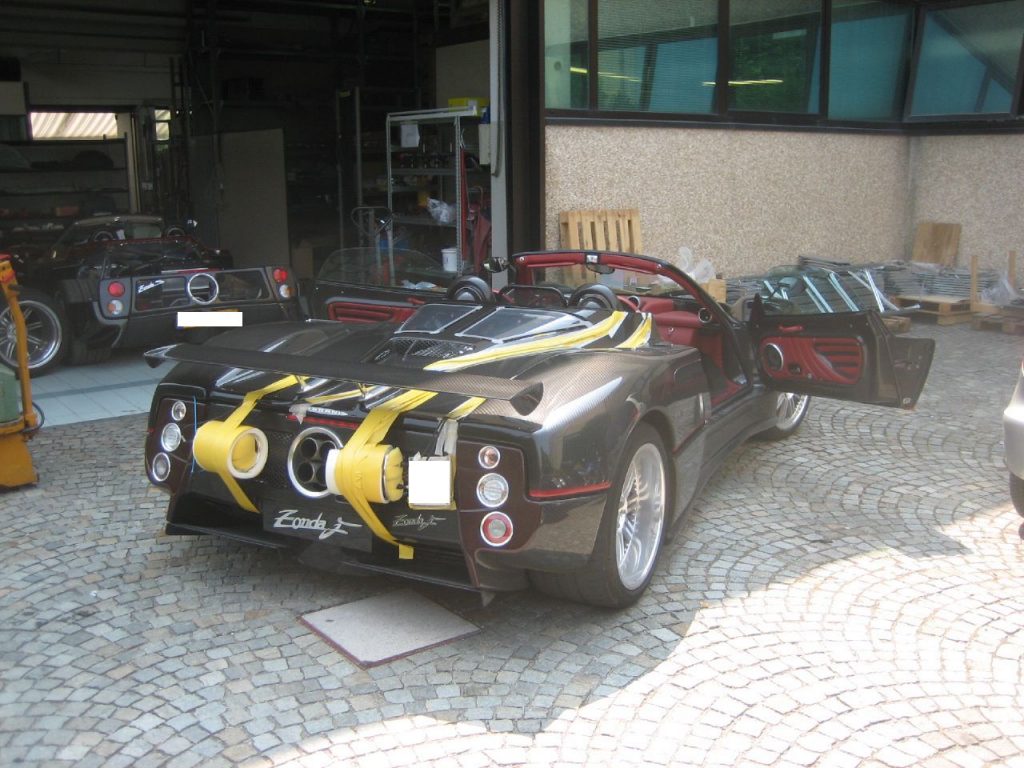
DS: Was there something related to sound you had hoped to accomplish that never got implemented?
BM: Not specifically in Burnout, but it’s always fun to keep an eye/ear on developments in racing titles, especially when it comes to car engines.
Granular systems with per grain DSP seem to be widespread these days, as is looking at tonal vs noise components across an RPM range. Some titles also, alongside tracking the fundamental frequency within the granular system, use Fourier resynthesis to generate the harmonics and can process these alongside the ‘real’ components; even removing the resynthesized component and just keeping the added harmonics (so 100% wet as it were).
Modelling resonance and pipe modelling (i.e. with changing exhaust systems) was always something I thought would be worth looking at.
After leaving Criterion and moving to DICE I got to work with the team behind Rallisport Challenge. Whilst working on Burnout we always referred to their AI cars as great sounding examples. Once at DICE I learnt from the audio team about embracing (and keeping!) the dirt, life and energy in ‘real’ recordings and how to twist these recordings to work in game versus the sanitisation of recordings into loops and fixed ramps, and then trying to add life back into these at runtime. Both have their place and an ideal solution will often use a bit of both techniques. The AI horns in the later PS2 NFSs are another great example of this embracing real live, ‘lively’ recordings and finding ways to use them in game.
DS: What are you most proud of within the series?
BM: The audio team at Criterion that built up over the franchise; a bunch of legends now dotted around the world, with most of them still working in game audio and many of whom are still close friends. It’s also fun meeting people who fondly remember playing the games years ago and hearing how they remember the bits you worked on. We did something different and did it our own way, and our players still appreciate that!
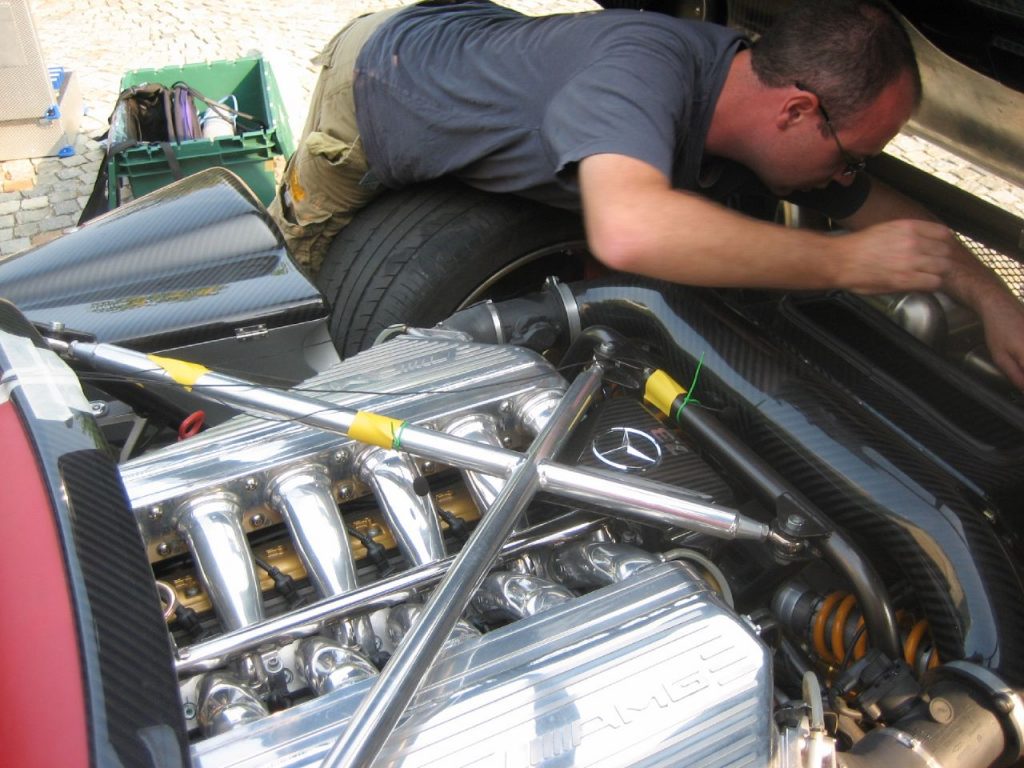
A big thank you to Ben Minto for delving into the past to answer our questions. At present, Ben is the audio director at EA DICE and is a vocal member of the sound design community.
For more, here’s an interview Ben gave with A Sound Effect where he discusses the future of game audio. You should also check out this Soundworks Collection interview with Ben, and this breakdown he did of the helicopter implementation for BF4 here on DesigningSound.org.
[…] Gould, R 2017, “Burnout” – a sound design retrospective with Ben Minto, blog post, 31 August, viewed 20 August 2018, <https://designingsound.org/2017/08/31/burnout-a-sound-design-retrospective-with-ben-minto/>. […]